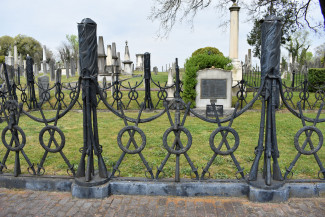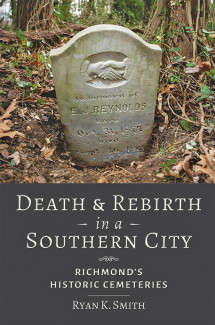
Johns Hopkins UniversityEst. 1876
America’s First Research University
Now Browsing:
Death and Rebirth in a Southern City

The memorial landscape in the United States has changed before our eyes. Death and Rebirth in a Southern City speaks to those changes through the lens of the historic cemeteries in Richmond, Virginia – the onetime capital of the Confederacy and heart of the Lost Cause.
One example can be found at the city’s Hebrew Cemetery, which hosts one of the nation’s earliest and most unusual Confederate memorials. In 1866, the Hebrew Ladies Memorial Association, affiliated with two local congregations, began raising funds to care for its Solders’ Section where thirty Jewish soldiers from across the South who died in the recent fighting had been gathered. The association’s members used the resulting funds to beautify the graves, raise individual headstones above them, and enclose the whole in a striking commemorative fence. Apparently the first monument to Confederate memory raised in the region, the cast-iron fence was unabashedly militaristic. It featured crossed swords and laurel wreaths as fencing set between posts composed of stacked rifles, swords, and furled flags topped by soldiers’ caps. It presented a rare celebration of Jewish military service. The association’s members also believed that “in time to come... when the malicious tongue of slander, ever so ready to assail Israel, shall be raised against us,” they would be able to signal their fidelity with this monument and say “There is our reply.” Indeed the soldiers’ memorial echoed the individual markers raised for Confederate soldiers in many other nearby cemeteries and pointed a path for the innumerable monuments to the Lost Cause that would proliferate throughout the region.

But just across the street from Hebrew Cemetery to the east, a new sort of memorial is rising. That acreage had been designated by the city as a burial ground for the enslaved and free people of color in 1815. The African Burying Ground on Shockoe Hill would grow to engulf Hebrew Cemetery and would host at least 22,000 graves, making it one of the largest and longest-serving burial grounds for the enslaved in the nation. After the city declared it full and ended burials there in 1879, a series of assaults by city engineers, land developers, and political leaders tore new projects through the property and scattered many of its graves. In 1960, the city government sold its original core to the Sun Oil Company for use as an automobile station. However, descendants, preservationists, and artists recently have stepped forward to reclaim the site. They have succeeded in prompting the city to re-acquire the initial acreage with plans to secure its place on the city’s commemorative Slave Trail. Its newly recognized burials include an enslaved grandmother, Kitty Cary, who in 1857 on her deathbed declared to surrounding family that “I am going home.”

Both sites show the power of graves and graveyards to shape our memories of the past and, at times, to surprise us. Both show what is at stake in the removal or recontextualization of public monuments valorizing the Confederacy. Amid the recent, public protests against racial injustice, the value of Confederate memorials within cemeteries has been reconfirmed, while at other sites, new, more challenging stories have arisen.
My book Death and Rebirth in a Southern City seeks to frame these changes by showing the long history of memorialization trends among the powerful alongside the continual efforts of the indigenous, the enslaved, and the marginalized to assert their humanity. Even more than in the city’s famed avenues, in the cemeteries today we can find rebirth.
Order Death and Rebirth in a Southern City: Richmond's Historic Cemeteries – published on November 17, 2020 – at the following link: https://jhupbooks.press.jhu.edu/title/death-and-rebirth-southern-city
Ryan K. Smith is a professor of history at Virginia Commonwealth University. He is the author of Death and Rebirth in a Southern City: Richmond's Historic Cemeteries, Robert Morris's Folly: The Architectural and Financial Failures of an American Founder, and Gothic Arches, Latin Crosses: Anti-Catholicism and American Church Designs in the Nineteenth Century.

One example can be found at the city’s Hebrew Cemetery, which hosts one of the nation’s earliest and most unusual Confederate memorials. In 1866, the Hebrew Ladies Memorial Association, affiliated with two local congregations, began raising funds to care for its Solders’ Section where thirty Jewish soldiers from across the South who died in the recent fighting had been gathered. The association’s members used the resulting funds to beautify the graves, raise individual headstones above them, and enclose the whole in a striking commemorative fence. Apparently the first monument to Confederate memory raised in the region, the cast-iron fence was unabashedly militaristic. It featured crossed swords and laurel wreaths as fencing set between posts composed of stacked rifles, swords, and furled flags topped by soldiers’ caps. It presented a rare celebration of Jewish military service. The association’s members also believed that “in time to come... when the malicious tongue of slander, ever so ready to assail Israel, shall be raised against us,” they would be able to signal their fidelity with this monument and say “There is our reply.” Indeed the soldiers’ memorial echoed the individual markers raised for Confederate soldiers in many other nearby cemeteries and pointed a path for the innumerable monuments to the Lost Cause that would proliferate throughout the region.

Hebrew Cemetery in Richmond, Virginia. Photo by Ryan Smith.
But just across the street from Hebrew Cemetery to the east, a new sort of memorial is rising. That acreage had been designated by the city as a burial ground for the enslaved and free people of color in 1815. The African Burying Ground on Shockoe Hill would grow to engulf Hebrew Cemetery and would host at least 22,000 graves, making it one of the largest and longest-serving burial grounds for the enslaved in the nation. After the city declared it full and ended burials there in 1879, a series of assaults by city engineers, land developers, and political leaders tore new projects through the property and scattered many of its graves. In 1960, the city government sold its original core to the Sun Oil Company for use as an automobile station. However, descendants, preservationists, and artists recently have stepped forward to reclaim the site. They have succeeded in prompting the city to re-acquire the initial acreage with plans to secure its place on the city’s commemorative Slave Trail. Its newly recognized burials include an enslaved grandmother, Kitty Cary, who in 1857 on her deathbed declared to surrounding family that “I am going home.”

Site of the African Burying Ground on Shockoe Hill in Richmond, Virginia, with Hebrew Cemetery in the background. Photo by Ryan Smith.
Both sites show the power of graves and graveyards to shape our memories of the past and, at times, to surprise us. Both show what is at stake in the removal or recontextualization of public monuments valorizing the Confederacy. Amid the recent, public protests against racial injustice, the value of Confederate memorials within cemeteries has been reconfirmed, while at other sites, new, more challenging stories have arisen.
My book Death and Rebirth in a Southern City seeks to frame these changes by showing the long history of memorialization trends among the powerful alongside the continual efforts of the indigenous, the enslaved, and the marginalized to assert their humanity. Even more than in the city’s famed avenues, in the cemeteries today we can find rebirth.
Order Death and Rebirth in a Southern City: Richmond's Historic Cemeteries – published on November 17, 2020 – at the following link: https://jhupbooks.press.jhu.edu/title/death-and-rebirth-southern-city
Ryan K. Smith is a professor of history at Virginia Commonwealth University. He is the author of Death and Rebirth in a Southern City: Richmond's Historic Cemeteries, Robert Morris's Folly: The Architectural and Financial Failures of an American Founder, and Gothic Arches, Latin Crosses: Anti-Catholicism and American Church Designs in the Nineteenth Century.

Login to View & Leave Comments
Login to View & Leave Comments


